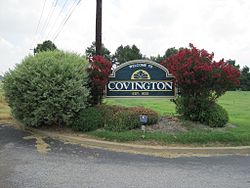Covington, Tennessee
| Covington, Tennessee | |
|---|---|
| City | |
 |
|
| Nickname(s): The Heart of Tipton County | |
 Location in Tipton County and the state of Tennessee. |
|
| Coordinates: 35°33′54″N 89°38′50″W / 35.56500°N 89.64722°WCoordinates: 35°33′54″N 89°38′50″W / 35.56500°N 89.64722°W | |
| Country | United States of America |
| States of the United States | Tennessee |
| County | Tipton |
| Area | |
| • Total | 10.3 sq mi (26.7 km2) |
| • Land | 10.3 sq mi (26.7 km2) |
| • Water | 0.0 sq mi (0.0 km2) |
| Elevation | 335 ft (102 m) |
| Population (2010) | |
| • Total | 9,038 |
| • Density | 877.5/sq mi (338.5/km2) |
| Time zone | Central (CST) (UTC-6) |
| • Summer (DST) | CDT (UTC-5) |
| ZIP code | 38019 |
| Area code(s) | 901 |
| FIPS code | 47-17680 |
| GNIS feature ID | 1281435 |
| Website | www |
Covington is a city in central Tipton County, Tennessee. Covington is the largest city and county seat of Tipton County. The city is located in West Tennessee, a few miles from the Mississippi River. The city's population was 9,038 at the time of the 2010 U.S. Census. Located about 42 miles northeast of Memphis, Covington is part of the Memphis, Tennessee Metropolitan Area.
The Covington area was originally inhabited by Native Americans of various tribes. They used the nearby Mississippi River as a trading route among numerous American Indian nations, who for more than 1,000 years conducted continent-deep trading between the upper river and the Southeast. Evidence of such trading has been found in materials and items excavated from numerous archeological sites.
Tipton County is one of five present-day counties of the State of Tennessee that border the Mississippi River. The first Europeans to explore this area were attached to the noted expedition of the French Canadians Jacques Marquette and Louis Joliet in 1673. This expedition went down the Mississippi from present-day Wisconsin to the mouth of the Arkansas River, and then back upriver to Lake Michigan. The Arkansas River represents part of the border between present-day Arkansas and Mississippi. It is likely that de Soto and his men passed near here circa 1541.
During the 19th century, because this entire area consists of fertile floodplains and a climate of long, hot summers, and adequate rainfall, the Covington area and the rest of West Tennessee were developed for cotton plantations. This became the primary commodity crop across the South in the 19th century, generating great wealth for many large planters. African-American slaves were brought to Western Tennessee by planters relocating here, or forced here by sale in the domestic slave trade. West Tennessee was the center of large-scale slavery in Tennessee, and Memphis had a major slave market. Planters and farmers in Middle Tennessee also held slaves, although in fewer number. Farmers in the eastern part of the state mostly developed small subsistence farms and held few slaves.
...
Wikipedia
